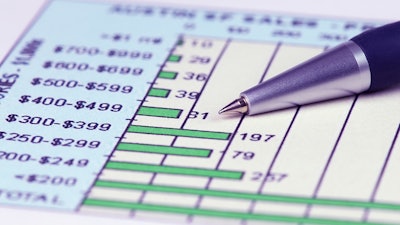
Dana Incorporated announced financial results for the fourth quarter and full-year 2020.
“Reflecting on 2020, it was truly a unique year and challenging environment. As a result of the hard work and dedication of the Dana team, we proved we could adapt and excel when faced with the most severe of business environments, delivering strong sales and rebounding margins as we ended the year with positive free cash flow,” says James Kamsickas, Dana chairman and CEO.
“We also further secured our leadership position in the e-Mobility space with 50 percent of our $700 million new business backlog coming from electric or hybrid programs, demonstrating our promise to lead in this fast-growing segment,” Kamsickas says. “Our success in rapidly penetrating the electric-vehicle market is a direct result of our strategy and the investments we have made over the past several years. As we move forward, we are well-positioned to capitalize on our momentum and realize the potential of our business.”
Sales for the fourth quarter of 2020 totaled $2.11 billion, compared with $1.99 billion in the same period of 2019, representing a $121 million improvement driven by strong customer demand and the conversion of sales backlog, primarily in the Light Vehicle segment.
Net income attributable to Dana was $40 million for the fourth quarter of 2020, compared with $85 million in the same period of 2019. The difference was primarily due to higher interest expense, one-time costs, and taxes. Partially offsetting these higher expenses was a $33 million gain on investments.
Reported diluted earnings per share was $0.27, compared with diluted earnings per share of $0.58 in the fourth quarter of 2019.
Adjusted EBITDA for the fourth quarter of 2020 was $192 million, compared with $226 million for the same period in 2019. This was a result of higher incremental costs associated with elevated demand and the nonrecurrence of a $17 million indirect tax expense recovery in Brazil in 2019, along with accelerated investments in electrification.
Diluted adjusted earnings per share were $0.24 in the fourth quarter of 2020, compared with $0.67 in the same period of the prior year. The lower year-over-year comparison was primarily due to lower earnings.
Operating cash flow in the fourth quarter of 2020 was $191 million, compared with $349 million in the same period of 2019.
Adjusted free cash flow was $46 million, compared with $218 million in the fourth quarter of 2019. Lower cash generation was driven by lower earnings, higher cash income taxes and interest, and lower cash generated from working capital as sales continued to recover from the COVID-related shutdowns.
Full-year 2020 financial results
Sales for 2020 were $7.1 billion, compared with $8.6 billion in 2019. The decrease is primarily attributable to weaker demand across all mobility markets due to customers idling operations through the middle of the year in response to the global COVID-19 pandemic.
The net loss attributable to Dana was $31 million, compared with net income of $226 million in 2019. The loss resulted mainly from the goodwill impairment charge recorded during the onset of the global pandemic. Reported diluted earnings per share was a loss of $0.21, compared with $1.56 in 2019.
Adjusted EBITDA for 2020 was $593 million, or 8.3 percent of sales. Margin variance to the prior year was driven by the rapid reduction in sales due to pandemic-related shutdowns in the second quarter outpacing cost-reduction actions and higher incremental costs to meet elevated demand during the rapid restart of operations in the third quarter.
Diluted adjusted earnings per share for 2020 were $0.39, compared with $3.06 in 2019, primarily reflecting lower year-over-year earnings and higher depreciation and interest.
The company reported operating cash flow of $386 million in 2020. Adjusted free cash flow was $60 million, or about 1 percent of sales, compared with $272 million, or 3 percent of sales in 2019. The impact of lower profit in 2020 was partially offset by targeted cash conservation measures, lower cash taxes, and lower capital expenditures.
“Our cost-saving actions and strong financial position allowed us to manage through this challenging year,” says Jonathan Collins, Dana executive vice president and chief financial officer, regarding 2021 guidance. “We are positioned for long-term sales, profit, and free cash flow growth while continuing to improve our strong balance sheet.
2021 financial targets
- Sales of $8.05 to $8.55 billion;
- Adjusted EBITDA of $860 million to $960 million, an implied adjusted EBITDA margin of approximately 11 percent at the midpoint of the range;
- Diluted adjusted EPS of $1.90 to $2.40;
- Operating cash flow of approximately 7.5 percent of sales; and
- Adjusted free cash flow of approximately 3 percent of sales.
Dana’s board of directors elected to reinstate the company’s quarterly dividend of $0.10 per share on its common stock. This will be payable on March 26, 2021, to holders of Dana common stock as of March 5, 2021. The board of directors also extended Dana’s share repurchase authorization through the end of 2023. There is $150 million remaining under the authorization.
Leveraging renewable energy sources
In the fourth quarter, Dana announced a commitment to reduce its total annual greenhouse gas emissions by at least 50 percent before the end of 2035, representing a reduction of more than 300,000 metrics tons of carbon dioxide emissions annually. This action aligns with the Paris Climate Agreement and further supports the company’s vision of aiding its customers in achieving their sustainability objectives.
To help meet this goal, Dana has signed a long-term agreement to add 300,000 megawatt-hours annually in renewable electricity to the grid beginning in 2022. In return, Dana will receive the equivalent quantity of renewable energy credits to address approximately 90 percent of the company’s annual U.S. electricity consumption.











